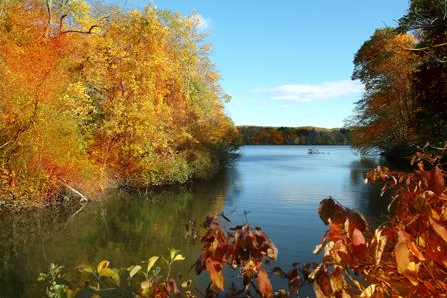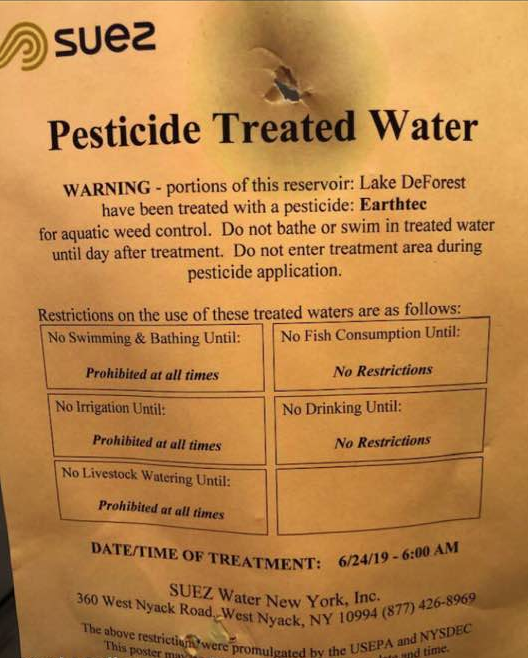
CLARKSTOWN, N.Y.—Hackensack Riverkeeper Program Director Hugh Carola says he’s not concerned about Suez Water New York’s recent application of pesticide at Lake DeForest Reservoir.
The reservoir is owned and operated by Suez North America and is the most upstream of its reservoirs along the river’s watershed, the others being Lake Tappan, the Woodcliff Lake Reservoir, and the Oradell Reservoir.
Suez posted that Lake DeForest had been treated with a pesticide, EarthTec, for aquatic weed control.
It warned boldly, “Pesticide Treated Water: Do not bathe or swim in treated water until day after treatment. Do not enter treatment area during pesticide application.”
Some residents, on seeing Suez’s pesticide poster at the site leading up to June 24 at 6 a.m., had expressed worry on “Everything Nyack” on Facebook.

One person who saw Suez’s sign later posted on Facebook, “I am thankful I have a well, a very deep well, with clean cold wonderful water.”
Another wrote in part, “There is just no way to be safe from pesticides anymore no matter how many [personal] organic choices you make.”
Still another wrote, “If you read up on what they [Suez NY] are using you will see that it is copper [and] that it is effective and safe.”
Swimming and bathing always are disallowed there because the water is reserved for potable use.
Against this backdrop, Pascack Press/Northern Valley Press reached out to Carola to ask whether he was concerned about the application of pesticide at Lake DeForest.
“The short answer is no,” he said.
He explained that because massive musty-smelling algal blooms are striking fresh-, brackish- and saltwater bodies all across North America, the move is prudent.
He said ongoing nutrient pollution from agricultural and other fertilizer runoff added to warm temperatures and generally higher-than-normal rainfall culminated in “a kind of perfect storm that results in excess algae and the potential for HABs [Harmful Algal Blooms]” at the reservoir and elsewhere in the Garden State and beyond.
Indeed, Lake Hopatcong, the largest freshwater body in New Jersey, forming part of the border between Sussex and Morris counties in the northern highlands, was recently closed to swimming and other longstanding recreation purposes over a devastating and historic algae bloom.
The state Department of Environmental Protection called the damage at Lake Hopatcong “the first of this magnitude in New Jersey.”
The DEP on July 17 confirmed the extensive presence of a HAB at Greenwood Lake, advising people to avoid swimming or coming in contact with the water there.
Lake DeForest is a reservoir in Clarkstown, New York, created in 1956 by impounding the
Hackensack River, which is a principal part of the water supply for Rockland County, New York, and northern New Jersey, mainly Bergen and Hudson counties.
EarthTec bills its product for lakes and reservoirs an algaecide and bactericide safe and effective in combatting organic compounds produced by cyanobacteria, commonly known as blue-green algae.
“We can detect the problem before you start getting complaints and begin using a very low dose of EarthTec to kill the algae that is present and prevent it from turning into a much larger problem,” EarthTec says.
“By monitoring the problem we can help your normal taste and odor event become a shorter episode with fewer complaints from your customers,” it adds.
Hackensack Riverkeeper Inc., which defends the public trust resources of the Hackensack River Watershed through environmental action, advocacy, education and litigation, fought Suez when it was called United Water NJ, when it was selling off woods to developers. Ultimately the company stopped the practice.
“I know that in other places Suez gets a bad rap from advocates categorically opposed to water privatization but we must understand that the drinking water resources of the upper Hackensack River Watershed have been private since 1866,” Carola said.
“Public trust” is a legal principle that certain natural and cultural resources are preserved for public use, and that the government owns and must protect and maintain these resources for the public’s use. The doctrine’s most frequent application is to bodies of water.
Suez North America, founded as the Hackensack Water Co. in 1869 and later named United Water, is headquartered in Paramus. It says it owns and operates 16 water and wastewater utilities, and operates 90 municipal water and wastewater systems through public-private partnerships and contract agreements.
Carola said Hackensack Riverkeeper maintains a good relationship with both Suez Water New Jersey and Suez Water New York and conducts paddling events each year on three of the four reservoirs.
“That relationship was in large measure forged as a result of litigation brought by us and Bergen SWAN against United Water NJ over violations regarding the NJ Watershed Review Board rules,” he said.
Carola added, “One thing I can say without reservation is that the folks at Suez New York are nothing if not thorough. From our perspective they dot every i and cross every t and then some.”
He said, “There is nothing in our experience with the company over the past 10-plus years that would cause us concern. If anything, the New York team is uber-careful.”
A Suez spokesperson said the company applied EarthTec to Oradell Reservoir the first week of July.
“Application of a copper sulfate product is made in order to control algae that can contribute to taste and odor in the water supply,” the company said. “ This treatment [consisted] of using EarthTec and [was] applied by boat.”
The utility announced it applied copper sulfate to Oradell Reservoir in June 2017 and 2018.
Reservoirs ‘need constant help’
Carola, who conducts upward of 150 eco-cruises aboard the research vessel Robert H. Boyle II (there also is a sister vessel, the Geraldine Theresa) and oversees environmental programs that engage more than 10,000 people each year, said that “regardless of how they look as you pass by them, reservoirs are artificial lakes that were designed and built by humans to serve a human need.”
Lake DeForest, he explained, is only 63 years old, “two more than me.”
He said that “Like all reservoirs, Lake DeForest needs constant human stewardship because it’s not evolved as have ‘real’ lakes, which are usually much deeper than reservoirs.”
Carola told Pascack Press/Northern Valley Press that this year lakes such as Hopatcong and Greenwood— which he noted were formed about 12,000 to 15,000 years ago, following the retreat of the Wisconsin Glacier—are dealing with major algal problems “due to the hundreds, if not thousands of septic systems surrounding each.”
“So yeah, something has to be done to deal with the algae in DeForest, which like all Suez reservoirs is very shallow and so it warms quicker and allows for greater blooms.”
He said that in looking at all the options “Suez has obviously chosen the only one available, but based on what I’ve read they’ve chosen a company that is not a one-stop-shop for chemistry but rather one that specializes only in appropriate water treatment.”
Carola said “That’s a good thing and something we’d expect from Suez, having worked closely with them for over 10 years.
As for those who were alarmed at Suez’s notice, Carola said, “It probably didn’t help that [the utility] used a generic poster. It probably freaked out a few folks.”
He added that “With no limits on fish consumption or drinking—though of course, the water flows from DeForest to Lake Tappan to Oradell Reservoir to the Haworth Treatment Plant before heading to my house—I’m personally not concerned and I’d say the same professionally.”
For more information on Hackensack Riverkeeper, including its Eco-Cruises, Guided Paddles, canoe and kayak rentals, River Cleanups, Bird-Walks, indoor presentations, scholarships, and other offerings, visit hackensackriverkeeper.org.
